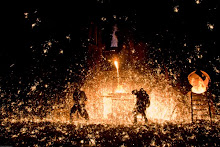CP&I was closed for most of the month of August while Glenn and I traveled to Germany as part of an art exchange called Salem2Salem. It was an exchange between Salem, Germany and Salem Art Works in Salem, New York
http://salemartworks.com/. Needless to say, it was an amazing experience. We were among 36 artists working in the disciplines of
digital art, literature, music, painting, photography and sculpture who lived, worked and otherwise "played" together in Castle Salem. We will always remember our fellow residents and hope to see them all next year here in the states. If you'd like to know more about the project, the website link is http://www.salem2salem.de/
We were both thrilled for the opportunity to create art in such a beautiful environment and learn so much about Germany and it's culture. Glenn was finally able to take off his "foundry hat" and relax into a true creative process, as I'm sure you will see in the images below.
The making of the armature.
The rough modeling of the clay.
Finished clay surface.
The textures used were gathered from the shop here in West Rutland, and from the grounds around Salem Germany.
Plaster waste mold in process.
The mold was chipped away.
The plaster sculpture after the waste mold is removed.

Making the forged steel clips at our good friend Michael Denker's shop. Michael is the castle's Kunstschmied und Schlossermeister (blacksmith and locksmith). Great guy. Very talented.
Using pigments to finish the surface.
The clips represent human attempts to repair the damage caused by our neglect and greed.
There is a golden forged steel sprout (shown below) breaking through the surface that speaks of mother's nature's wisdom and strength to prevail, even beyond man's best efforts.
"Mother Knows Best" hanging in the Neue Museum at Schloss Salem.
I will continue to periodically write about the CP&I European Tour, but for now it's back to West Rutland....and 80 Marble Street, otherwise known as the old Joy Theatre.


























































